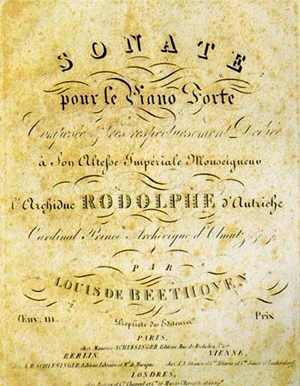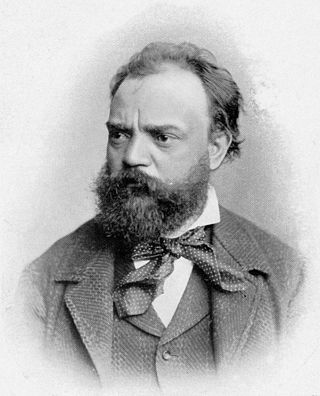
The Symphony No. 8 in F major, Op. 93 is a symphony in four movements composed by Ludwig van Beethoven in 1812. Beethoven fondly referred to it as "my little Symphony in F", distinguishing it from his Sixth Symphony, a longer work also in F.

The Symphony No. 4 in B♭ major, Op. 60, is the fourth-published symphony by Ludwig van Beethoven. It was composed in 1806 and premiered in March 1807 at a private concert in Vienna at the town house of Prince Lobkowitz. The first public performance was at the Burgtheater in Vienna in April 1808.

The String Quartet No. 6 in B-flat major, Op. 18, No. 6, was written between 1798 and 1800 by Ludwig van Beethoven and published in 1801, and dedicated to Joseph Franz von Lobkowitz.

Ludwig van Beethoven's Symphony No. 1 in C major, Op. 21, was dedicated to Baron Gottfried van Swieten, an early patron of the composer. The piece was published in 1801 by Hoffmeister & Kühnel of Leipzig. It is not known exactly when Beethoven finished writing this work, but sketches of the finale were found to be from 1795.

The Piano Sonata No. 32 in C minor, Op. 111, is the last of Ludwig van Beethoven's piano sonatas. The work was written between 1821 and 1822. Like other late period sonatas, it contains fugal elements. It was dedicated to his friend, pupil, and patron, Archduke Rudolf.

The Symphony No. 8 in G major, Op. 88, B. 163, is a symphony by Antonín Dvořák, composed in 1889 at Vysoká u Příbramě, Bohemia, on the occasion of his election to the Bohemian Academy of Science, Literature and Arts. Dvořák conducted the premiere in Prague on 2 February 1890. In contrast to other symphonies of both the composer and the period, the music is cheerful and optimistic. It was originally published as Symphony No. 4.

Ludwig van Beethoven's Piano Sonata No. 3 in C major, Op. 2, No. 3, was written in 1795 and dedicated to Joseph Haydn. It was published simultaneously with his first and second sonatas in 1796.

Ludwig van Beethoven completed his String Quartet No. 12 in E♭ major, Op. 127, in 1825. It is the first of his late quartets. Commissioned by Nicolas Galitzin over a year earlier, the work was not ready when it was scheduled to premiere. When it finally premiered by the Schuppanzigh Quartet, it was not well received. Only with subsequent performances by the Bohm Quartet and the Mayseder Quartet did it begin to gain public appreciation.
The Symphony in C major by German composer Robert Schumann was published in 1847 as his Symphony No. 2, Op. 61, although it was the third symphony he had completed, counting the B-flat major symphony published as No. 1 in 1841, and the original version of his D minor symphony of 1841. It is dedicated to Oscar I, king of Sweden and Norway.
The two Serenades, Op. 11 and 16, represent early efforts by Johannes Brahms to write orchestral music. They both date from after the 1856 death of Robert Schumann when Brahms was residing in Detmold and had access to an orchestra.

Ludwig van Beethoven's Piano Sonata No. 5 in C minor, Op. 10, No. 1 was composed some time during 1796–98.
The Symphony No. 98 in B♭ major, Hoboken I/98, is the sixth of the twelve London symphonies composed by Joseph Haydn. It was completed in 1792 as part of the set of symphonies composed on his first trip to London. It was first performed at the Hanover Square Rooms in London on 2 March 1792. Some musicologists and historians interpret this symphony as Haydn’s tribute to his friend Mozart who had died on 5 December 1791.

The Symphony No. 5 in E-flat major, Op. 82, is a three-movement work for orchestra written from 1914 to 1915 by the Finnish composer Jean Sibelius. He revised it in 1916 and again from 1917 to 1919, at which point it reached its final form.
Beethoven's Piano Sonata No. 11 in B♭ major, Op. 22, was composed in 1800, and published two years later. Beethoven regarded it as the best of his early sonatas, though some of its companions in the cycle have been at least as popular with the public.
The Septet in E-flat major for clarinet, horn, bassoon, violin, viola, cello, and double bass, Op. 20, by Ludwig van Beethoven, was sketched out in 1799, completed, and first performed in 1800 and published in 1802. The score contains the notation: "Der Kaiserin Maria Theresia gewidmet". It was one of Beethoven’s most popular works during his lifetime, much to the composer's dismay. Several years later, Beethoven even wished the score to have been destroyed, saying: "That damn work! I wish it were burned!"
Cello Sonatas No. 1 and No. 2, Op. 5, are two sonatas for cello and piano written by Ludwig van Beethoven in 1796, while he was in Berlin. While there, Beethoven met the King of Prussia Friedrich Wilhelm II, an ardent music-lover and keen cellist. Although the sonatas are dedicated to Friedrich Wilhelm II, Ferdinand Ries tells us that Beethoven "played several times at the court, where he also played the two cello sonatas, opus 5, composed for Duport and himself". Although Jean-Pierre Duport was one of the King's teachers, it is now thought to have been his brother Jean-Louis Duport who had the honor of premiering these sonatas.
The Piano Sonata No. 3 in F minor, Op. 5 of Johannes Brahms was written in 1853 and published the following year. The sonata is unusually large, consisting of five movements, as opposed to the traditional three or four. When he wrote this piano sonata, the genre was seen by many to be past its heyday. Brahms, enamored of Beethoven and the classical style, composed Piano Sonata No. 3 with a masterful combination of free Romantic spirit and strict classical architecture. As a further testament to Brahms' affinity for Beethoven, the Piano Sonata is infused with the instantly recognizable motive from Beethoven's Symphony No. 5 during the first, third, and fourth movements. Composed in Düsseldorf, it marks the end of his cycle of three sonatas, and was presented to Robert Schumann in November of that year; it was the last work that Brahms submitted to Schumann for commentary. Brahms was barely 20 years old at its composition. The piece is dedicated to Countess Ida von Hohenthal of Leipzig.

The Symphony No. 4 in D minor, Op. 13, B. 41, is a classical composition by Antonín Dvořák.

The Symphony No. 3 in E♭ major, Op. 10, B. 34, is a classical composition by Antonín Dvořák.
The Symphony No. 4 in C minor, D 417, is a symphony by Franz Schubert completed in April 1816 when Schubert was 19 years old, a year after his Third Symphony However, it was not premiered until November 19, 1849, in Leipzig, more than two decades after Schubert's death. The symphony was called the Tragic by its composer.











